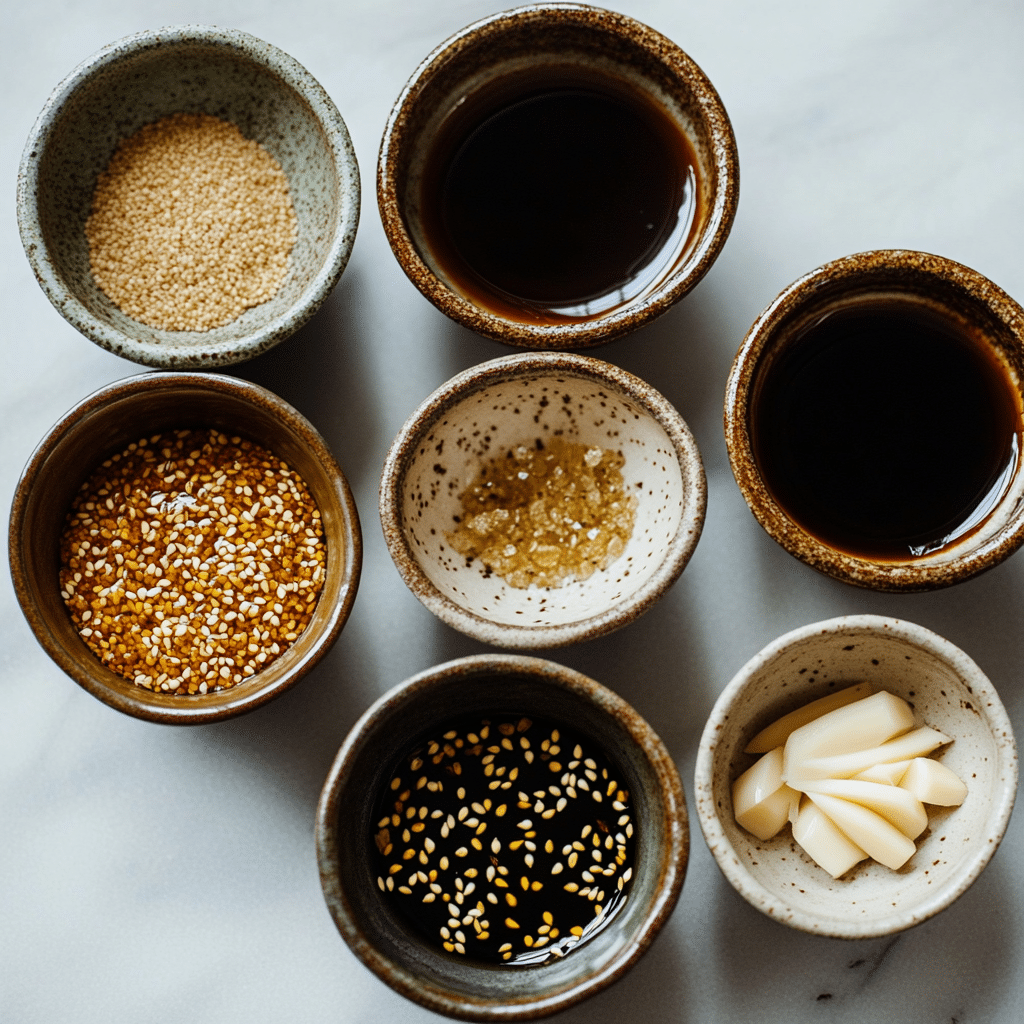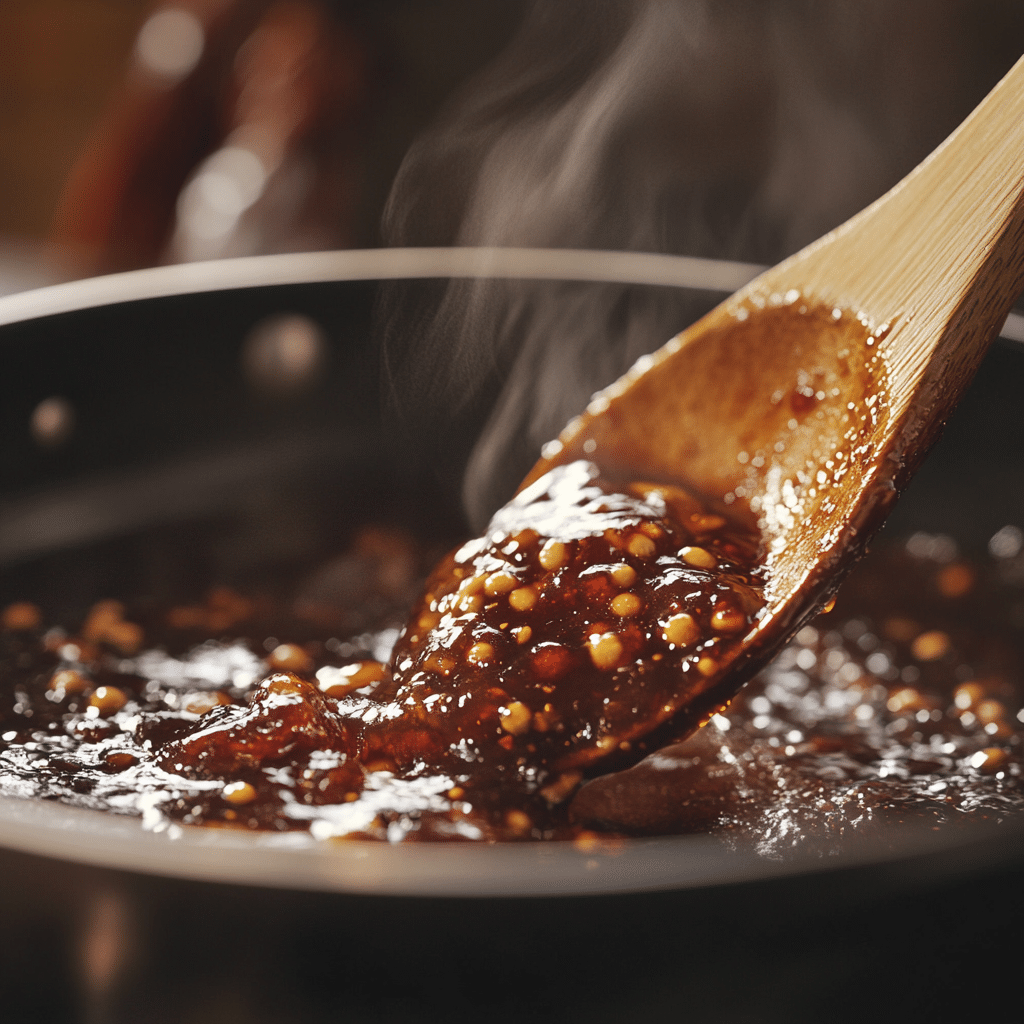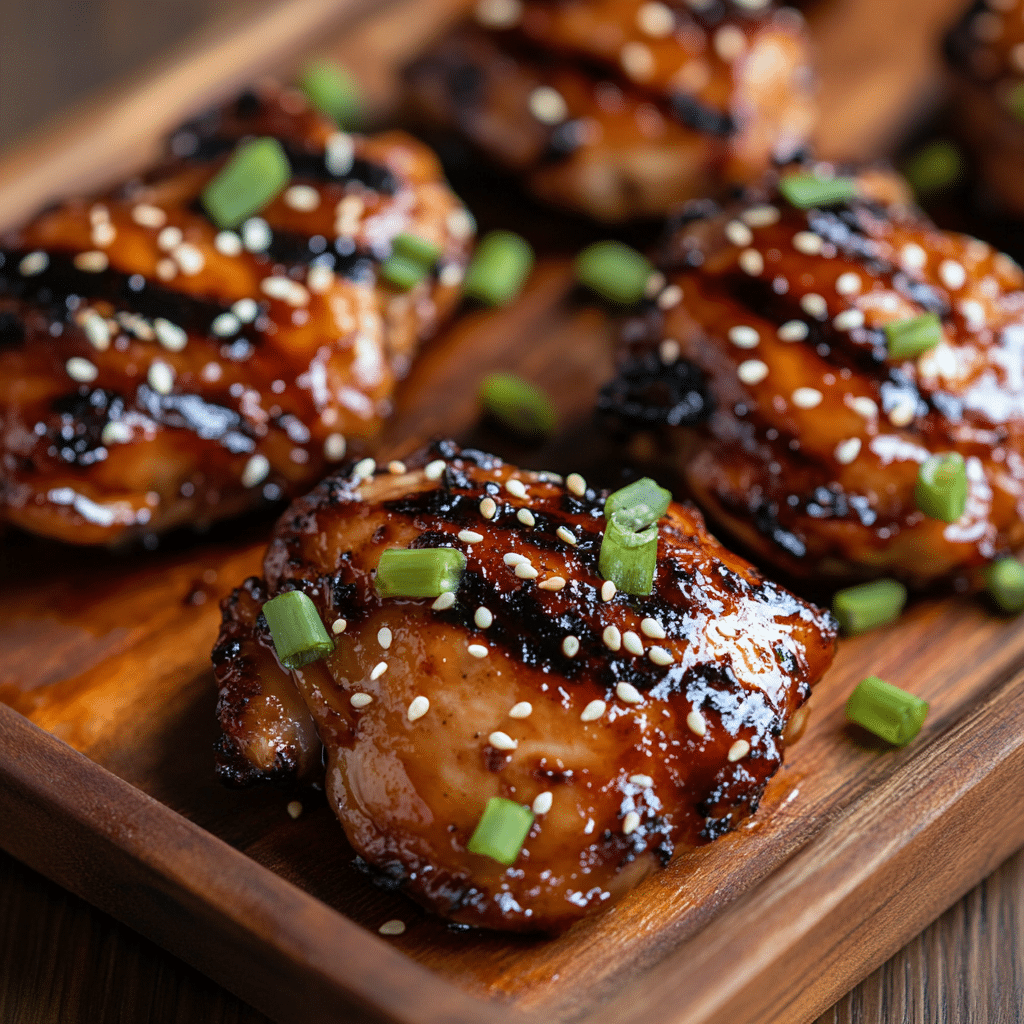If you’re someone who adores smoky-sweet barbecue flavors but wants to explore something more exciting, Asian barbecue sauce is a game changer. In this guide, we’ll explore its ingredients, cultural variations, and its incredible versatility—from Korean spice to Japanese umami. Plus, you’ll get my homemade Korean BBQ sauce recipe straight from my kitchen. With links to other flavor-packed ideas like Hawaiian BBQ chicken and vinegar-based barbecue sauce, this is your starting point to elevate any grilled dish.

A Family Story Behind My Love for Asian Barbecue Sauce
Where It All Began
Growing up, the kitchen was the heart of our home. My mother crafted meals that felt like warm hugs, and her way with sauces was unmatched. Years later, when I first tasted Korean barbecue sauce—sticky, spicy, and deep with umami—I was instantly reminded of her comforting flavors. I still remember making it one stormy evening; the aroma alone felt like a celebration of family dinners past.
Now, Asian barbecue sauce is a staple in my kitchen. It turns simple grilled meats into restaurant-level meals and works magic even on tofu or veggies. The flavor is just unbeatable. I used it recently in a twist on gluten-free barbecue and couldn’t believe how well it adapted. It’s one of those sauces that just makes sense across so many dishes.
What Is Asian Barbecue Sauce Made Of?
At its core, Asian barbecue sauce combines soy sauce, brown sugar, garlic, and ginger—a base built for rich umami. To that, we add rice wine vinegar, sesame oil, and region-specific spices. Korean versions use gochujang for chili heat. Chinese styles often lean on hoisin or five-spice. Japanese varieties may include mirin and fruit purees like apple or pear for sweetness.
This combination of savory, sweet, tangy, and spicy is what sets it apart. It’s perfect for marinating or glazing meats, like I did with my sticky BBQ chicken musubi that fused Korean and Hawaiian flair.
Why Asian BBQ Sauce Deserves a Spot in Your Pantry
Unlike traditional Western sauces heavy on tomato and molasses, Asian barbecue sauces balance salty, sweet, and spicy elements with grace. They caramelize beautifully under high heat, making them perfect for grilling. Just imagine ribs with that glossy, sticky finish—yeah, it’s that good.
I even drizzled it on roasted cauliflower steaks (like the ones in my smoked cauliflower steak recipe), and the result was nothing short of spectacular. Whether you’re grilling outdoors or searing indoors, this sauce transforms anything it touches.
Print
Asian Barbecue Sauce
- Total Time: 10 minutes
- Yield: 1 cup 1x
Description
This sticky Korean-style Asian barbecue sauce is rich, sweet, spicy, and perfect for grilling or dipping.
Ingredients
1 cup soy sauce
¾ cup dark brown sugar
2 tablespoons minced garlic
1 tablespoon rice wine vinegar
1 tablespoon gochujang (Korean chili paste)
1 ½ teaspoons ground black pepper or gochugaru
1 teaspoon grated fresh ginger
1 teaspoon sesame oil
1 tablespoon cornstarch
1 tablespoon water
Instructions
1. Combine soy sauce, brown sugar, garlic, vinegar, gochujang, pepper, ginger, and sesame oil in a saucepan.
2. Bring to a boil over medium heat, stirring often.
3. Mix cornstarch and water in a small bowl until smooth.
4. Slowly add cornstarch slurry to the saucepan.
5. Reduce heat and simmer for 3–5 minutes until thickened.
6. Cool and transfer to a jar or container for storage.
Notes
Store in the refrigerator for up to one week.
Perfect for grilled meats, veggies, or tofu.
- Prep Time: 5 minutes
- Cook Time: 5 minutes
- Category: Sauce
- Method: Simmering
- Cuisine: Asian
Nutrition
- Serving Size: 1 tablespoon
- Calories: 35
- Sugar: 5g
- Sodium: 390mg
- Fat: 0.5g
- Saturated Fat: 0.1g
- Unsaturated Fat: 0.4g
- Trans Fat: 0g
- Carbohydrates: 6g
- Fiber: 0.2g
- Protein: 0.5g
- Cholesterol: 0mg
Korean BBQ Sauce: The Bold Heart of Asian Barbecue Sauce
Korean Flavors that Define Asian Barbecue Sauce
Among the many regional variations of Asian barbecue sauce, the Korean version stands out for its balance of bold, sweet, and spicy flavors. It’s crafted with staples like soy sauce, brown sugar, garlic, and the famous gochujang—a fermented Korean chili paste that gives the sauce its signature depth and heat.
Korean BBQ sauce isn’t just a condiment; it’s a flavor-packed enhancer designed to glaze meats with a sticky, glossy coating. Whether you’re basting ribs or tossing tofu, this sauce turns any dish into a feast. I love brushing it over grilled meats, much like I do with my Texas BBQ sausage recipe, but with a spicy Korean twist.
Unlike many American-style sauces, Asian barbecue sauce doesn’t rely on tomatoes. Instead, it leans on umami-rich components like soy and sesame. Korean versions take that base and kick it up with heat and fermentation, making it one of the most exciting subtypes of Asian barbecue sauce out there.
This version also pairs beautifully with global fusion dishes. I’ve used it with Cajun-style barbecue from my Cajun BBQ sauce recipe and even in Korean-Mexican tacos. Its bold character holds up across the board.
Easy Korean Asian Barbecue Sauce Recipe (Sticky & Spicy)

If you’ve never made Korean Asian barbecue sauce at home, you’re in for a treat. Here’s a reliable recipe you can whip up in under 10 minutes using pantry staples.
Ingredients:
- 1 cup soy sauce
- ¾ cup dark brown sugar
- 2 tablespoons minced garlic
- 1 tablespoon rice wine vinegar
- 1 tablespoon gochujang (Korean chili paste)
- 1 ½ teaspoons black pepper or gochugaru (Korean chili powder)
- 1 teaspoon grated fresh ginger
- 1 teaspoon sesame oil
- 1 tablespoon cornstarch
- 1 tablespoon water
Instructions:

- Blend base ingredients: In a saucepan, mix soy sauce, brown sugar, garlic, vinegar, gochujang, pepper, ginger, and sesame oil. Bring it to a boil over medium heat, stirring frequently.
- Thicken: In a small bowl, combine cornstarch and water until smooth. Slowly add it to the boiling sauce, whisking continuously.
- Simmer and serve: Lower the heat and simmer for 3–5 minutes until thick and sticky. Cool before using or refrigerate for up to one week.
This recipe captures the essence of Korean Asian barbecue sauce—sticky, sweet, slightly spicy, and totally addictive. I love it brushed onto grilled chicken thighs or as a glaze for roasted vegetables. It’s a game changer when used in Korean-style sliders or brushed over grilled shrimp.
You can also pair this bold sauce with other regional specialties like Hawaiian BBQ chicken for a sweet-savory combo, or even layer it into your own version of BBQ chicken musubi for an island-meets-Korea twist.
Regional Variations of Asian Barbecue Sauce: Chinese vs. Japanese Styles
Why Is Chinese Barbecue Sauce So Distinct?
Chinese-style Asian barbecue sauce is known for its bold, slightly sweet, and savory flavor with layers of complexity. The base usually includes hoisin sauce, soy sauce, honey or sugar, garlic, and five-spice powder. Some recipes may also call for fermented black bean paste or Shaoxing wine for depth.
This version is thicker and more pungent than others, making it ideal for slow-roasted meats like char siu pork. That sticky red glaze you see on Chinese BBQ ribs? That’s the hallmark of this sauce. It clings beautifully to meats and forms that flavorful caramelized crust we all crave.
Unlike Korean versions that lean on heat, Chinese Asian barbecue sauce focuses on sweetness, umami, and aromatics. It pairs well with dishes where you want a balance of sugar and salt without too much spice. I love using it in fusion recipes, like tossing it with roasted veggies or glazing meatballs.
Chinese sauce also complements fusion spins on classics. For instance, I layered it into a version of Buffalo Wild Wings chipotle rub for a Chinese-American flavor bomb. The results? Totally addictive.
If you’re experimenting with international barbecue at home, pairing Chinese BBQ sauce with the milder elements in my low-sodium barbecue sauce can give you a health-conscious, flavorful option.
What Makes Japanese Barbecue Sauce So Good?
Japanese Asian barbecue sauce—often referred to as yakiniku tare or teriyaki-style BBQ sauce—is smoother, more refined, and slightly sweeter than other variations. Its standout ingredients include soy sauce, mirin, sake, sugar, and fruit purée, typically pear or apple. This adds natural sweetness and a luxurious glaze when grilled.
Where Korean BBQ sauce is bold and spicy, Japanese barbecue sauce is mellow and velvety, with a flavor profile that’s incredibly balanced. It’s often brushed over skewers, grilled fish, or chicken, like the ones you’d see in my upcoming Japanese grilled salmon with tare glaze—a recipe that brings elegance to backyard grilling.
This version of Asian barbecue sauce is ideal for seafood, vegetables, and chicken wings. The sauce thickens gently and delivers a gorgeous sheen that enhances presentation and flavor.
Its versatility also makes it a great addition to veggie-focused dishes. I’ve used it over grilled cauliflower, inspired by my smoked cauliflower steaks, and it added just the right note of sweetness and savoriness.
Japanese sauces can be found bottled, but making them at home is surprisingly easy. It only takes a few staple ingredients to recreate this light yet deeply flavorful Asian barbecue sauce that’s both kid-friendly and gourmet-ready.
Creative Ways to Use Asian Barbecue Sauce Beyond the Grill
Unique Everyday Recipes with Asian Barbecue Sauce

What makes Asian barbecue sauce so valuable in the kitchen is how effortlessly it adapts to everyday meals—not just grilling. While it’s perfect for ribs, skewers, and charred meats, it also works wonders as a marinade, stir-fry base, or even a bold salad dressing ingredient.
One of my favorite off-the-grill uses is in fusion wraps and sandwiches. I’ve layered it into sliders and even tossed it with shredded chicken to stuff into bao buns. It also plays well in rice bowls, adding depth when drizzled over jasmine rice and roasted veggies, especially since the components in Asian barbecue sauce work similarly to marinades by affecting surface moisture and flavor absorption [source]. You’d be amazed how well it pairs with smoky Cajun-inspired dishes like my Cajun BBQ sauce—offering sweet and spicy contrast in every bite.
You can use it as a flavorful dip for egg rolls or grilled shrimp. I’ve even stirred it into ramen broth for an umami kick. When you start treating Asian barbecue sauce as a staple condiment rather than a specialty item, its potential multiplies.
This adaptability is exactly why I combined it with elements from my vinegar-based barbecue sauce to create a smoky-sweet glaze for grilled portobello mushrooms—and the result was crave-worthy.
Healthier Twists and Dietary Swaps
Want a lighter take on Asian barbecue sauce? You can modify it easily. Try reducing the sugar or swapping it for honey or maple syrup. Coconut aminos work as a lower-sodium soy sauce alternative, and gluten-free tamari lets you cater to gluten-free diets without losing flavor.
I’ve experimented with versions that blend in fresh orange juice, grated apple, or even pineapple for brightness and sweetness—perfect for chicken, tofu, or seafood. It even works beautifully over grilled fruit like pineapple rings, transforming them into sweet-savory sides or dessert toppings.
If you’re following a specific dietary plan, it helps to blend Asian barbecue sauce with staples from lighter recipes—like the base from my gluten-free barbecue sauce—to create balanced, better-for-you marinades.
I also love using it in meal prep. Add it to roasted cauliflower steaks (like these smoked cauliflower steaks), grain bowls, or mason jar salads. The sauce keeps well and intensifies over time, making weekday lunches exciting instead of bland.
Frequently Asked Questions
What is Asian barbecue sauce made of?
Asian barbecue sauce typically includes soy sauce, brown sugar, garlic, ginger, sesame oil, and rice vinegar. Regional variations like Korean, Chinese, and Japanese versions may add gochujang, hoisin, or mirin for deeper flavor.
Why is Chinese barbecue sauce different?
Chinese barbecue sauce often uses hoisin sauce, five-spice powder, and fermented bean paste, giving it a sweet, umami-rich taste with bold aromatics. It’s thicker and more concentrated than other styles.
What is different about Korean barbecue sauce?
Korean barbecue sauce features gochujang, a spicy fermented chili paste, along with soy sauce, brown sugar, garlic, and sesame oil. It’s known for being spicy, sticky, and savory all at once.
Why is Japanese barbecue sauce so good?
Japanese barbecue sauce is smooth and balanced, made with soy sauce, mirin, sake, and fruit purées like pear or apple. It offers a sweet-savory profile that works beautifully on grilled meats, seafood, and vegetables.
Conclusion
Whether you’re basting ribs, glazing tofu, or turning a rice bowl into something extraordinary, Asian barbecue sauce is your flavor-packed ally in the kitchen. Each version—Korean, Chinese, or Japanese—brings its own magic, transforming even the simplest ingredients into something memorable.
It’s not just a sauce. It’s a bridge between cultures and a reflection of bold culinary creativity. Try it with smoky twists like my Buffalo chipotle rub or mellow it out in fusion with low-sodium BBQ. However you use it, the outcome is always the same: absolutely delicious.
